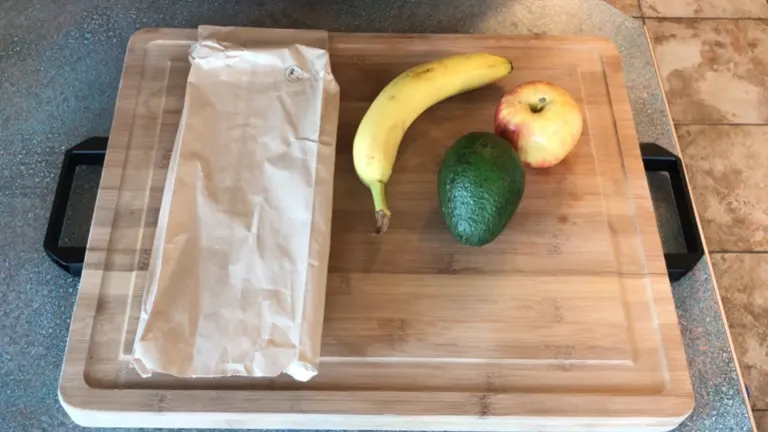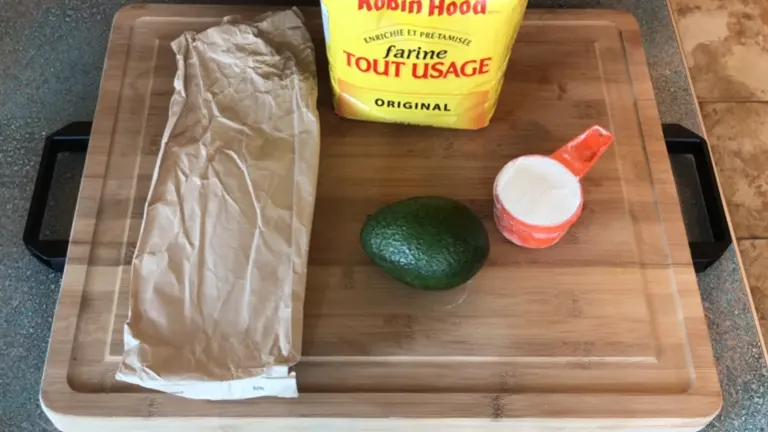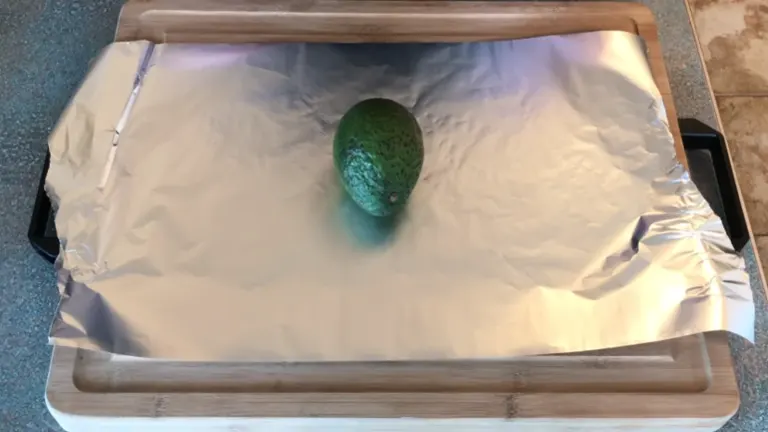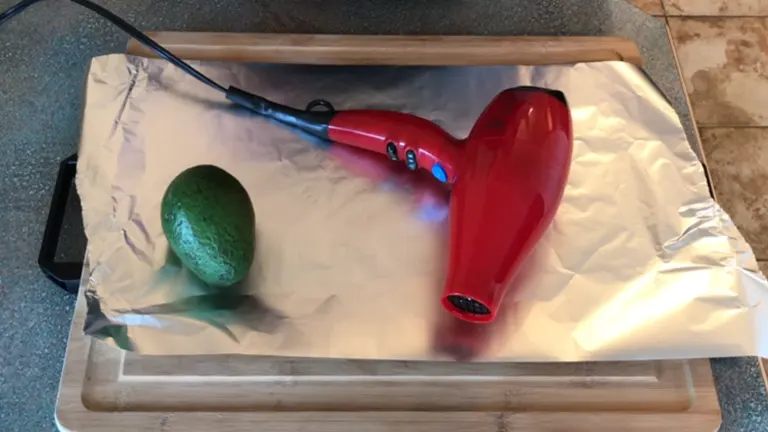How To Ripen An Avocado Fast: Testing 5 Popular Methods
- May 6, 2024
- 0 comment
If you’ve ever needed a ripe avocado quickly but only had rock-hard ones at hand, you know the frustration. It’s a common scenario for avocado lovers: the craving strikes, but the avocado isn’t ready. I set out to test the five most popular methods claimed to ripen avocados fast, using five unripe avocados to see which technique delivers the best results.
List of 5 Popular Methods to Ripen an Avocado Fast:
- The Natural Approach
- The Fruit Bag Method
- The Flour Power Technique
- The Oven Method
- The Hair Dryer Technique
Method 1: The Natural Approach
When it comes to ripening avocados, the Natural Approach is as straightforward and gentle as it gets. This method involves placing an avocado on a windowsill where it is exposed to ambient warmth and sunlight. It’s a completely passive technique that mimics the natural ripening process without any interventions.

The Natural Approach leverages the gradual effects of sunlight and the ambient temperature of your home to promote the ripening of the avocado. Sunlight helps warm the avocado, which can accelerate the natural enzymatic reactions that cause ripening.
Procedure
- Choose a windowsill or another spot where the avocado will receive plenty of natural light and some indirect sunlight.
- Set the avocado on the windowsill. If you have multiple avocados, make sure they are spaced out to allow air to circulate around them.
- This method requires time, typically several days, depending on the initial ripeness of the avocado and the amount of sunlight and warmth it receives.
Advantages
- No additional materials are required—just the avocado and a windowsill.
- This method doesn’t require any purchases or unusual equipment.
- The avocado ripens slowly, which can lead to more even softness and potentially better flavor development.
Considerations
- It can take several days for an avocado to ripen using this method, so it’s not suitable if you need a ripe avocado quickly.
- The effectiveness of this method can vary greatly depending on the climate you live in and the time of year, as both affect the amount of natural warmth and sunlight available.
The Natural Approach is perfect for those who plan ahead and prefer not to interfere with the avocado’s natural ripening process. While it requires patience and is dependent on environmental conditions, this method ensures that your avocado ripens without the need for artificial aids, maintaining its natural taste and texture in the most organic way possible.
Method 2: The Fruit Bag Method
One of the most popular quick-ripening techniques involves using a simple paper bag with a banana and an apple. This method utilizes the natural ethylene gas produced by these fruits to expedite the ripening process of avocados. Ethylene gas, often referred to as the “ripening hormone,” is a natural compound that fruits release, which speeds up the ripening process.

To use this method, place an unripe avocado in a paper bag along with a banana and an apple. The key here is the closed environment of the paper bag, which traps the ethylene gas emitted by the banana and apple. This concentrated ethylene environment accelerates the avocado’s ripening.
Procedure
- You will need a paper bag large enough to hold a couple of fruits along with the avocado without being too cramped.
- Place the unripe avocado in the bag along with a ripe banana and a ripe apple. These fruits are chosen because they are among the highest producers of ethylene gas.
- Roll the open end of the bag closed to trap the ethylene gas inside. Ensure there is still some air space inside the bag to allow gas circulation.
- Keep the bag at room temperature, typically on a kitchen counter away from direct sunlight. The avocado usually ripens in about 1 to 3 days, depending on its initial stage of ripeness.
- It’s advisable to check the avocado’s softness daily by gently pressing the skin. Be careful not to bruise the fruit.
Advantages
- This method can significantly speed up the ripening process, usually taking only a few days.
- It uses common household fruits and a simple paper bag, making it an accessible method for anyone.
- The process uses the natural gases from fruits, avoiding any artificial chemicals or treatments.
While effective, this method does depend on the ripeness of the accompanying fruits. Overripe fruits will produce more ethylene, potentially speeding up the process even further. However, it’s important to note that if left too long, the fruits themselves might overripen or rot, which could affect the smell and cleanliness of the bag.
Method 3: The Flour Power Technique
The “Flour Power Technique,” an intriguing variation that involves a paper bag and some common kitchen flour. While flour itself doesn’t chemically accelerate the ripening process, it plays a unique role in this method.

This technique utilizes the insulating and absorbent properties of flour to create an even more controlled environment within the paper bag. The theory here is that the flour helps maintain a consistent level of ethylene gas around the avocado by absorbing excess moisture and preventing any external environmental changes from affecting the ripening process.
Procedure
- You will need a paper bag and about a half cup of all-purpose flour.
- Insert the unripe avocado into the paper bag.
- Sprinkle the half cup of flour around the avocado, ensuring it’s somewhat surrounded but not buried.
- Fold or roll the open end of the bag to close it, keeping the internal atmosphere rich in ethylene gas produced by the avocado.
- Place the bag in a warm, dry place out of direct sunlight and check daily.
Advantages
- The enclosed bag traps the avocado’s natural ethylene gas, enhancing the ripening effect.
- Flour absorbs excess moisture, which may help prevent spoilage or mold, especially in more humid environments.
- Flour can help buffer any temperature or humidity fluctuations, providing a more consistent ripening environment.
Considerations
- It’s important to check the avocado regularly, as the flour might obscure physical changes in the fruit’s texture. Gently feel the avocado through the bag to determine softness.
- Ensure that the flour does not get damp or clumpy, as this can counteract its benefits and potentially lead to mold if left unchecked.
While the Flour Power Technique might sound a bit quirky, it’s based on creating an optimal ripening environment by regulating ethylene gas and moisture. This method is particularly suited for those who live in humid climates or find that their avocados and other fruits tend to over-ripen or spoil quickly. By trying this method, you might find it to be an effective way to ripen avocados evenly and at a controlled pace.
Method 4: The Oven Method
Using the oven might seem like a quick fix. I decided to give this method a try by wrapping an avocado in tin foil and placing it in a preheated oven. This method uses heat to soften the avocado, a technique quite different from the usual room-temperature ripening.

The concept behind the oven method is to apply gentle heat to the avocado, which theoretically should accelerate the ripening process by softening the flesh. By wrapping the avocado in tin foil, the idea is to evenly distribute the heat and avoid direct hot spots that could cook the fruit unevenly.
Procedure
- Set your oven to a low temperature—around 200°F (about 93°C) is recommended to avoid cooking the avocado.
- Completely cover the avocado in tin foil, ensuring there are no gaps or holes where heat can escape.
- Set the wrapped avocado on an oven-safe dish to catch any potential drips, then place it in the oven.
- The time needed can vary, but generally, 10-15 minutes should be sufficient. It’s important to check the avocado frequently to prevent overcooking.
- Carefully remove the avocado from the oven and tin foil, and check if it has softened to your preference.
Advantages
- This method can significantly reduce the time it takes to soften an avocado, making it almost immediately usable if softness is the only requirement.
Considerations
- The heat alters the avocado’s texture, making it unusually soft and somewhat akin to a cooked sweet potato or yam. This texture is not ideal for dishes where the freshness and firmness of raw avocado are desired, such as in salads or guacamole.
- There’s a fine line between softening and cooking the avocado. If left in the oven too long, the avocado can begin to actually cook, changing its flavor and aroma to something more akin to roasted or baked vegetables.
The Oven Method is quick and can soften an avocado in a pinch, but it comes with significant drawbacks regarding the texture and taste of the fruit. This technique might work if you need extremely soft avocado for a blended application, like a smoothie or spread where texture is not an issue. However, for most culinary uses, especially those that rely on the distinct texture and flavor of fresh avocado, this method is not recommended. It’s an interesting experiment but ultimately not suitable for preserving the qualities most love about avocados.
Method 5: The Hair Dryer Technique
I tested the Hair Dryer Technique. This method involves using a common household tool, the hair dryer, to apply direct heat to the avocado wrapped in tin foil. This technique is thought to mimic the quicker ripening effects of the oven method but with more control over the heating process.

The Hair Dryer Technique uses the heat generated by the hair dryer to warm the avocado, potentially speeding up the ripening process by softening the flesh. The tin foil acts as a conductor, helping to distribute the heat more evenly around the avocado.
Procedure
- Completely encase the avocado in tin foil, ensuring there are no exposed areas.
- Turn on your hair dryer to a medium or high heat setting. Hold the hair dryer about 5-6 inches away from the avocado, moving it around to evenly distribute heat.
- Continuously apply heat for about 5-10 minutes, depending on the initial ripeness of the avocado. It’s important to monitor the process closely to avoid overheating.
- Periodically, pause heating and press the avocado gently to test its softness. Continue until it reaches the desired consistency.
- Once the avocado has softened slightly, allow it to cool before handling further.
Advantages
- Unlike the oven method, using a hair dryer gives you the ability to control the heat application more precisely, potentially preventing overheating.
- This method can soften an avocado faster than leaving it at room temperature, making it somewhat useful in urgent situations.
Considerations
- If the avocado is extremely unripe (very green and hard), this method might not effectively ripen the fruit to a satisfactory level.
- The technique can lead to uneven ripening, where some parts of the avocado may soften while others remain firm.
- Similar to the oven method, the heat can alter the natural texture and taste of the avocado, making it less ideal for fresh eating.
While the Hair Dryer Technique is a novel idea and can make an avocado softer in a short amount of time, it does not genuinely ripen the fruit in the way that natural processes or even the ethylene gas method does. The technique is best suited for scenarios where slight softening is adequate, and the texture changes are not detrimental to the intended use of the avocado. However, for those seeking the creamy, rich texture of a naturally ripened avocado, this method may disappoint. It’s a last resort option rather than a recommended ripening solution.
Recommendations
- Best Overall Method: The Flour Bag Method stands out as the winner for its ability to rapidly ripen the avocado while enhancing its texture and flavor. This method is highly recommended for those who need a ripe avocado quickly without compromising on quality.
- Best Natural Method: For those who prefer a more natural approach and have the time to wait, placing the avocado on a Natural Sunlight windowsill provides a reliable, albeit slower, ripening process.
- Quick Fix: If you’re short on time and the texture is not your primary concern (perhaps for recipes where the avocado is blended), the Fruit Bag Method can be a quick and effective solution.
- Methods to Avoid: Both the Oven and Hair Dryer Methods should generally be avoided unless absolutely necessary. These methods should only be considered as a last resort, as they significantly degrade the quality of the avocado.
Conclusion
The best fast-ripening method for avocados, based on my testing, is the paper bag method with flour. It not only speeds up the ripening but also enhances the avocado’s natural flavor and texture. The fruit bag method also works well, especially if you’re in a pinch and need a ripe avocado quickly. However, I strongly advise against using any heat-based methods like the oven or hair dryer, as they alter the fruit’s texture and taste.
Remember, while these hacks can help when you’re in a hurry, nothing beats naturally ripened avocados for that perfect balance of flavor and texture. Always plan ahead when you can, but now you know how to speed things up when needed!
FAQs
- Can I ripen an avocado overnight?
While none of the methods can ripen an avocado perfectly overnight, the Fruit Bag Method can significantly soften an avocado overnight, especially if it’s already beginning to mature. - Do avocados ripen faster in the fridge or on the counter?
Avocados ripen faster at room temperature on the counter. Refrigeration slows down the ripening process, which is useful if you want to extend the fruit’s life once it’s ripe. - How do ethylene gas emitters like apples and bananas help ripen avocados faster?
Apples and bananas emit ethylene gas, a natural plant hormone that accelerates ripening in nearby fruits. When placed in a confined space like a paper bag with avocados, this gas increases the rate at which avocados ripen. - Is there a risk to using the oven method to ripen avocados?
Yes, there is a risk of altering the avocado’s flavor and texture when using the oven method. The heat can cook the avocado, making it mushy and changing its natural taste, which is not ideal for raw culinary uses. - What are some signs that an avocado has over-ripened?Signs of an over-ripened avocado include very soft flesh that may feel mushy, dark brown or black spots inside, and an off smell. Such avocados may not be suitable for eating.
- Can I use a microwave to ripen an avocado?
It’s not recommended to use a microwave to ripen avocados as it can cook the fruit and alter its taste and texture significantly, similar to the oven method. - How can I tell if an avocado is ready to eat using the Flour Bag Method?
Check the avocado’s readiness by gently pressing the skin. If it yields to light pressure, it’s ripe. The flour in the bag helps trap ethylene, speeding up the ripening without affecting the texture negatively. - How can I tell if an avocado is ripe?
Gently squeeze in your palm; it should yield to slight pressure but not be mushy. Check under the stem cap—if it’s green underneath, it’s ripe. - What are some creative ways to use ripe avocados?
Besides avocado toast, you can blend them into smoothies, include them in sandwiches and salads, make crispy fries, or use them as a salad dressing.
We’d love to hear from you! Have you tried any of these avocado-ripening methods, or do you have a secret technique of your own? Drop a comment below and let us know how it went! If you’ve got friends or family who struggle with unripe avocados, why not share this article with them? Let’s spread the knowledge and enjoy perfectly ripe avocados together!

David Murray
Forestry AuthorI'm David Murry, a forestry equipment specialist with a focus on chainsaw operation. With over 13 years of experience, I've honed my skills in operating and maintaining a wide range of machinery, from chainsaws to log splitters. My passion for the outdoors and commitment to sustainable forestry drive my work, which emphasizes safety, efficiency, and staying updated with industry advancements. Additionally, I'm dedicated to sharing my expertise and promoting environmental awareness within the forestry community.













Leave your comment